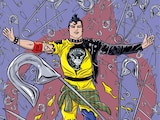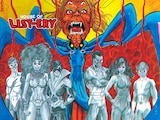Being a Green Lantern might seem fun…until your wife is killed, you wind up framed for murder, you’re tortured in prison and your arrogance leads to the destruction of an entire planet. This would be enough to destroy any man, but John Stewart is still standing. As we mark the final day of Black History Month, we’ll be taking a look at how this undeniably tough period in John Stewart’s life shaped who he is today, and what it could teach us about recovery, redemption and heroism.
It all started in Action Comics #601 when Star Sapphire murdered John’s wife, Katma Tui. John lashed out in anger, blaming Hal Jordan, since Star Sapphire had targeted Katma to get his attention. Star Sapphire then took advantage of John’s anger by taunting him while in her Carol Ferris form. John attacked Ferris in public, and she used her powers to make it seem like Stewart had killed her. John was arrested, but things were about to get worse.

Thanks to a case of mistaken identity, John Stewart was extradited to Africa for crimes that were actually done by Jordan. While imprisoned in South Nambia, John was abused by the corrupt guards. After reuniting with his power ring, he escaped and joined rebel forces to fight apartheid in South Africa. Since Carol’s body had disappeared, the murder charges were dropped against him, but John decided to take to the stars to clear his head and process everything he had been through.
When a piece of the Anti-Life Equation threatened the planet Xanshi, John teamed up with Martian Manhunter to save the planet (Cosmic Odyssey #1-4). Tragically, the Green Lantern arrogantly thought he could disarm the planetary bomb on his own, so he used his ring to send J’onn away. When John got to Xanshi’s core, he was surprised to learn that the Anti-Life bomb was coated in yellow—his power ring’s only weakness. Xanshi was destroyed seconds later in a fiery explosion that killed millions.

John had barely been holding it together since Kat’s murder, and the Xanshi affair completely shattered him. His power ring allowed him to feel every single death, and the guilt he felt was overwhelming. John nearly committed suicide, before Martian Manhunter stopped him with a tough love pep talk. John made the decision to carry on as a hero, but as everyone knows, this isn’t something that can be resolved in a single comic.
One theme commonly explored in superhero fiction is how our heroes cope with failure. We saw it when Batman failed to save Jason Todd in “Death in the Family” and when Superman failed to save Adam Grant in 1993’s Superman #84. When you’re a superhero, you can’t save every life, and that’s something they must live with. What happened with Xanshi was different, because John’s actions actually prevented the planet’s salvation. Martian Manhunter doesn’t have a weakness to yellow—he would have been able to disarm the bomb, saving the doomed world. This isn’t a situation where the hero couldn’t get somewhere on time. This was John’s overconfidence causing the deaths of millions.
One of the hardest parts of life is that there is no undo button. Sometimes we say or do things that have unintended negative consequences, and we have to live with those actions. In one instant, everything could change and that’s true whether you’re a Green Lantern or an ordinary human being. Even if we haven’t done anything like the Xanshi affair, most of us have struggled to live with our mistakes. The question is, when do regret and remorse become roadblocks to recovery?

With trauma, you have to accept that the hurt will never go away. It’s not about getting rid of your feelings, it’s about learning to cope with them. For years, John Stewart struggled with that, and thought that he could redeem himself by helping intergalactic refugees or working with the Darkstars. None of his triumphs could ease his guilt though, and a Xanshi survivor named Yrra Cynril told him that he needed to forgive himself. Yrra initially blamed John for the destruction of her world and reacted in anger before realizing the value of love and forgiveness. Still, while Yrra may have been able to forgive John, he wasn’t yet able to forgive himself.
The “Blackest Night” storyline forced John to face his trauma both literally and figuratively. John was visiting the ruins of Xanshi in an effort to confront his guilt once and for all when a series of Black Lantern power rings reassembled the planet and rebuilt the corpses of their inhabitants. Even worse, John’s late wife Kat was a part of the Black Lantern army, which only added to his trauma.
Most men would’ve crumbled over their biggest failures coming back to haunt them, but John was able to use this confrontation as a springboard to finally make peace with the past. “I accept the fact that as much as I build, I’ll never be able to replace my wife. Or your planet. But I’ll be damned if I let that destroy me anymore than I already have,” he said.

Stewart and the rest of the Green Lantern Corps were able to defeat the Black Lanterns, and John was finally able to move on with his life.
What makes someone a hero? It’s not just about how they triumph over evil, but about how they handle their losses. The scars from the death of his wife and the destruction of Xanshi will always be with John and he’s accepted that. Our greatest failures will always be a part of us, but that doesn’t mean they need to define us. John Stewart is one of the most inspiring heroes in the DC Universe, and we could all learn something from his road to recovery and acceptance.
Joshua Lapin-Bertone writes about TV, movies and comics for DCComics.com, is a regular contributor to the Couch Club and writes our monthly Batman column, "Gotham Gazette." Follow him on Twitter at @TBUJosh.















